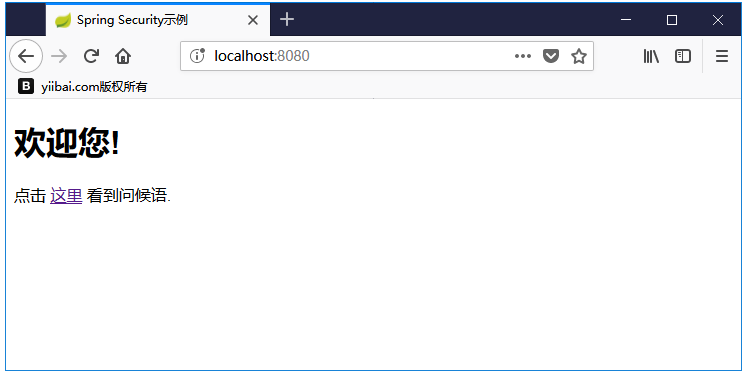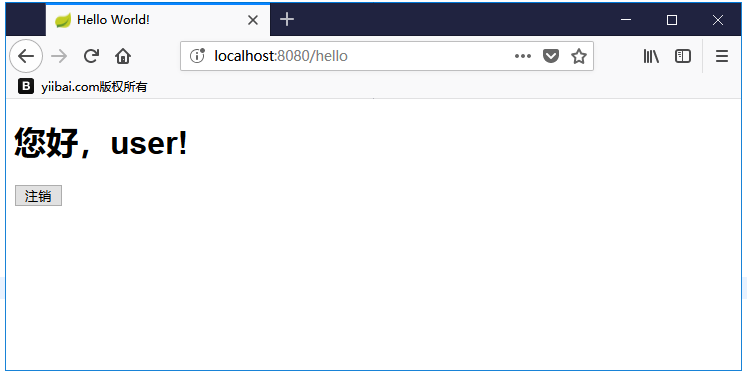Spring Boot保护Web应用程序
如果在类路径上添加了Spring Boot Security依赖项,则Spring Boot应用程序会自动为所有HTTP端点提供基本身份验证。端点“/”和“/home”不需要任何身份验证。所有其他端点都需要身份验证。
要将Spring Boot Security添加到Spring Boot应用程序,需要在构建配置文件中添加Spring Boot Starter Security依赖项。
Maven用户可以在pom.xml 文件中添加以下依赖项。
<dependency>
<groupId>org.springframework.boot</groupId>
<artifactId>spring-boot-starter-security</artifactId>
</dependency>
Gradle用户可以在build.gradle 文件中添加以下依赖项。
compile("org.springframework.boot:spring-boot-starter-security")
保护Web应用程序
首先,使用Thymeleaf模板创建不安全的Web应用程序。
然后,在 src/main/resources/templates 目录下创建一个home.html 文件。
<!DOCTYPE html>
<html xmlns = "http://www.w3.org/1999/xhtml"
xmlns:th = "http://www.thymeleaf.org"
xmlns:sec = "http://www.thymeleaf.org/thymeleaf-extras-springsecurity3">
<head>
<title>Spring Security示例</title>
</head>
<body>
<h1>欢迎您!</h1>
<p>点击 <a th:href = "@{/hello}">这里</a> 看到问候语.</p>
</body>
</html>
使用Thymeleaf模板在HTML文件中定义的简单视图/hello。现在,在src/main/resources/templates目录下创建一个文件:hello.html。
<!DOCTYPE html>
<html xmlns = "http://www.w3.org/1999/xhtml"
xmlns:th = "http://www.thymeleaf.org"
xmlns:sec = "http://www.thymeleaf.org/thymeleaf-extras-springsecurity3">
<head>
<title>Hello World!</title>
</head>
<body>
<h1>Hello world!</h1>
</body>
</html>
现在,需要为Home和hello视图设置Spring MVC - View控制器。为此,创建一个扩展WebMvcConfigurerAdapter的MVC配置文件。
package com.yiibai.websecuritydemo;
import org.springframework.context.annotation.Configuration;
import org.springframework.web.servlet.config.annotation.ViewControllerRegistry;
import org.springframework.web.servlet.config.annotation.WebMvcConfigurerAdapter;
@Configuration
public class MvcConfig extends WebMvcConfigurerAdapter {
@Override
public void addViewControllers(ViewControllerRegistry registry) {
registry.addViewController("/home").setViewName("home");
registry.addViewController("/").setViewName("home");
registry.addViewController("/hello").setViewName("hello");
registry.addViewController("/login").setViewName("login");
}
}
现在,将Spring Boot Starter安全依赖项添加到构建配置文件中。Maven用户可以在pom.xml 文件中添加以下依赖项。
<dependency>
<groupId>org.springframework.boot</groupId>
<artifactId>spring-boot-starter-security</artifactId>
</dependency>
Gradle用户可以在build.gradle 文件中添加以下依赖项。
compile("org.springframework.boot:spring-boot-starter-security")
现在,创建一个Web安全配置文件,该文件用于保护应用程序以使用基本身份验证访问HTTP端点。
package com.yiibai.websecuritydemo;
import org.springframework.beans.factory.annotation.Autowired;
import org.springframework.context.annotation.Configuration;
import org.springframework.security.config.annotation.authentication.builders.AuthenticationManagerBuilder;
import org.springframework.security.config.annotation.web.builders.HttpSecurity;
import org.springframework.security.config.annotation.web.configuration.WebSecurityConfigurerAdapter;
import org.springframework.security.config.annotation.web.configuration.EnableWebSecurity;
@Configuration
@EnableWebSecurity
public class WebSecurityConfig extends WebSecurityConfigurerAdapter {
@Override
protected void configure(HttpSecurity http) throws Exception {
http
.authorizeRequests()
.antMatchers("/", "/home").permitAll()
.anyRequest().authenticated()
.and()
.formLogin()
.loginPage("/login")
.permitAll()
.and()
.logout()
.permitAll();
}
@Autowired
public void configureGlobal(AuthenticationManagerBuilder auth) throws Exception {
auth
.inMemoryAuthentication()
.withUser("user").password("password").roles("USER");
}
}
现在,在src/main/resources 目录下创建一个login.html 文件,以允许用户通过登录屏幕访问HTTP端点。
<!DOCTYPE html>
<html xmlns = "http://www.w3.org/1999/xhtml" xmlns:th = "http://www.thymeleaf.org"
xmlns:sec = "http://www.thymeleaf.org/thymeleaf-extras-springsecurity3">
<head>
<title>Spring Security示例</title>
</head>
<body>
<div th:if = "${param.error}">
无效的用户名和密码.
</div>
<div th:if = "${param.logout}">
你已经注销.
</div>
<form th:action = "@{/login}" method = "post">
<div>
<label> 用户名 : <input type = "text" name = "username"/> </label>
</div>
<div>
<label> 密码: <input type = "password" name = "password"/> </label>
</div>
<div>
<input type = "submit" value = "登录"/>
</div>
</form>
</body>
</html>
最后,更新hello.html 文件 - 允许用户从应用程序注销并显示当前用户名,如下所示 -
<!DOCTYPE html>
<html xmlns = "http://www.w3.org/1999/xhtml" xmlns:th = "http://www.thymeleaf.org"
xmlns:sec = "http://www.thymeleaf.org/thymeleaf-extras-springsecurity3">
<head>
<title>Hello World!</title>
</head>
<body>
<h1 th:inline = "text">您好,[[${#httpServletRequest.remoteUser}]]!</h1>
<form th:action = "@{/logout}" method = "post">
<input type = "submit" value = "注销"/>
</form>
</body>
</html>
主 Spring Boot应用程序的代码如下 -
package com.yiibai.websecuritydemo;
import org.springframework.boot.SpringApplication;
import org.springframework.boot.autoconfigure.SpringBootApplication;
@SpringBootApplication
public class WebsecurityDemoApplication {
public static void main(String[] args) {
SpringApplication.run(WebsecurityDemoApplication.class, args);
}
}
下面给出了构建配置文件的完整代码。
Maven构建文件 - pom.xml 的内容如下:
<?xml version = "1.0" encoding = "UTF-8"?>
<project xmlns = "http://maven.apache.org/POM/4.0.0"
xmlns:xsi = "http://www.w3.org/2001/XMLSchema-instance"
xsi:schemaLocation = "http://maven.apache.org/POM/4.0.0
http://maven.apache.org/xsd/maven-4.0.0.xsd">
<modelVersion>4.0.0</modelVersion>
<groupId>com.yiibai</groupId>
<artifactId>websecurity-demo</artifactId>
<version>0.0.1-SNAPSHOT</version>
<packaging>jar</packaging>
<name>websecurity-demo</name>
<description>Demo project for Spring Boot</description>
<parent>
<groupId>org.springframework.boot</groupId>
<artifactId>spring-boot-starter-parent</artifactId>
<version>1.5.9.RELEASE</version>
<relativePath/> <!-- lookup parent from repository -->
</parent>
<properties>
<project.build.sourceEncoding>UTF-8</project.build.sourceEncoding>
<project.reporting.outputEncoding>UTF-8</project.reporting.outputEncoding>
<java.version>1.8</java.version>
</properties>
<dependencies>
<dependency>
<groupId>org.springframework.boot</groupId>
<artifactId>spring-boot-starter-security</artifactId>
</dependency>
<dependency>
<groupId>org.springframework.boot</groupId>
<artifactId>spring-boot-starter-thymeleaf</artifactId>
</dependency>
<dependency>
<groupId>org.springframework.boot</groupId>
<artifactId>spring-boot-starter-web</artifactId>
</dependency>
<dependency>
<groupId>org.springframework.boot</groupId>
<artifactId>spring-boot-starter-test</artifactId>
<scope>test</scope>
</dependency>
<dependency>
<groupId>org.springframework.security</groupId>
<artifactId>spring-security-test</artifactId>
<scope>test</scope>
</dependency>
</dependencies>
<build>
<plugins>
<plugin>
<groupId>org.springframework.boot</groupId>
<artifactId>spring-boot-maven-plugin</artifactId>
</plugin>
</plugins>
</build>
</project>
Gradle构建文件 – build.gradle
buildscript {
ext {
springBootVersion = '1.5.9.RELEASE'
}
repositories {
mavenCentral()
}
dependencies {
classpath("org.springframework.boot:spring-boot-gradle-plugin:${springBootVersion}")
}
}
apply plugin: 'java'
apply plugin: 'eclipse'
apply plugin: 'org.springframework.boot'
group = 'com.yiibai'
version = '0.0.1-SNAPSHOT'
sourceCompatibility = 1.8
repositories {
mavenCentral()
}
dependencies {
compile('org.springframework.boot:spring-boot-starter-security')
compile('org.springframework.boot:spring-boot-starter-thymeleaf')
compile('org.springframework.boot:spring-boot-starter-web')
testCompile('org.springframework.boot:spring-boot-starter-test')
testCompile('org.springframework.security:spring-security-test')
}
现在,创建一个可执行的JAR文件,并使用以下Maven或Gradle命令运行Spring Boot应用程序。
Maven用户请使用下面给出的命令 -
mvn clean install
在“BUILD SUCCESS”之后,可以在target目录下找到JAR文件。
Gradle用户可以使用如下所示的命令 -
gradle clean build
在“BUILD SUCCESSFUL”之后,可以在build/libs 目录下找到JAR文件。
现在,使用下面显示的命令运行JAR文件 -
java –jar <JARFILE>
在Web浏览器中访问URL => http://localhost:8080/ ,将看到如下图所示。

输入用户名和密码(user/password),然后点击登录 -

看到问候语如下:




